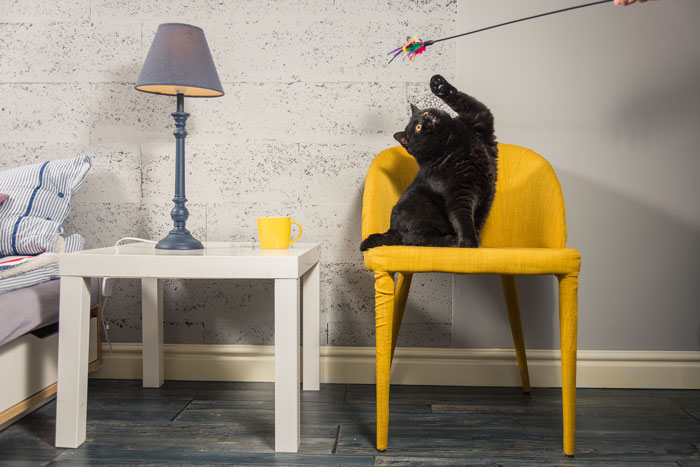Feline preferences matter when choosing interactive toys and games.
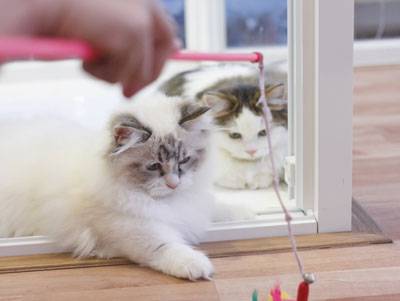
©amthinkin/Adobe Stock
Every person and cat will have their own playtime preferences. If you don’t know what your cat enjoys, this article can help you figure that out. However, before I begin: If you and your cat are enjoying yourselves (and you’re not encouraging unwanted behaviors), there’s no wrong way to play. What matters is that you are doing it together; all cats need to play.
Read more about our unique Cat Training course.
The first thing to remember is cats are predators. This means exploring methods of play that engage their hunting instincts. Cats all have different hunting styles and their individual style will elicit the best response if you cater to their specific preferences.
As predators, hunting precedes feeding. In a domestic setting, this translates to playtime before mealtime. But, a typical cycle in a cat’s day is to play (hunt), eat, and then sleep. Disruption to this cycle can result in behavior problems and physiological changes, such as problems with weight gain or behavior changes.
Lurkers
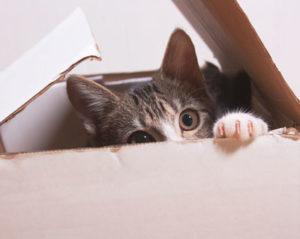
©alexmia/Adobe Stock
Some cats are excellent at hiding and bursting out to ambush a playmate or “prey.” For these types of personalities, you should choose cat furniture that lets them hide, such as a tunnel, cat condo, or even a cardboard box or blanket fort. Anything they can hide in and leap out at “prey,” such as dangling wand toys is an ideal addition to your cat’s home environment.
If you have a cat who loves to hide and ambush, there are many great ways to play with them. Make sure there are plentiful hidey-holes, and use a wand toy, a laser pointer or something as simple as a peacock feather to simulate prey moving outside their little cave. Don’t shove the toy into their hiding place, as this will ruin the feeling of ambushing their prey.
Climbers
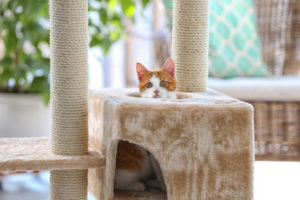
©Africa Studio/Adobe Stock
Some cats prefer climbing and love to be up high. If you allowed them outdoors, they would likely spend time observing activity from a tree top. It’s important to give these cats plenty of opportunities to climb during the day. Not only will it give them a new place to relax and nap, but it will give them more confidence around you, your family and your other pets.
Consider installing shelves that allow your cat to leap across platforms and use a teaser toy that they can chase from platform to platform. There are a number of great companies out there who create innovative wall units. Take a look at Hauspanther’s new line of cat shelves.
If you’re not able to construct shelving for your cat, consider picking up a couple of tall cat trees. (I love these lifelike trees from Pet Tree Houses.)
Personally, my favorite wand toy to use anywhere in the house is NekoFlies Ultimate Rod toy. The longer rod gives me lots of reach for climbing cats and allows me to coax them from one shelf to another. But, it also serves as the perfect lure system for encouraging play in any type of hunter.
Solo-Play Toys
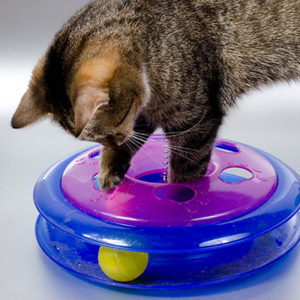
©Sarka/Adobe Stock
Automated solo-play toys, like the Frolicat Fox Den Toy that extends a fox paw out in random patterns, are ideal for entertaining cats while their human is busy. My cats love to watch the movement, then pounce at the perfect moment. I can even leave this toy on while I’m working to make sure my cats are entertained (ideal for conference calls).
The Smart Cat Peek A Prize Toy Box is another fun way to encourage activity. This wooden box features extra holes that you can easily place roll toys inside and then let your cat entertain himself by grabbing at the toys within.
Keep in mind that solo-play is never a replacement for you playing with your cat. Solo-play should never be the only time a cat gets to “hunt,” since you know the moves your cat wants from their “prey” and can replicate them better than any machine or solo-play toy.
Feeding Time
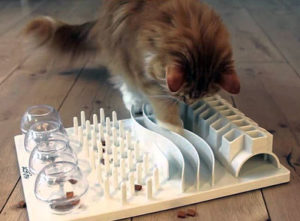
When feeding your cat, it’s good to remember that they should earn their meal. This means letting the cat play (and win) before feeding time and/or using feeding puzzles. Feeding puzzles are especially helpful in cats that tend to eat too quickly. Not only do feeding puzzles help slow your cats down during feeding times, but also helps them eat in a more natural way.
Consider a feeding game like the Doc & Phoebe’s Hunting Game. In this game, you place your cat’s food in individual “toy mice.” Then you hide the mice in different areas of the house. Your cat will quickly discover that he has to hunt for his food throughout the day as he gets hungry. This is a much more natural approach to feeding for cats and can help decrease tummy trouble, keep your cat active and encourage hunting behavior.
There are many other types of feeding puzzles and toys that you can incorporate into a feline hunter’s day. The Wooly Snuffle Mat from Paw5 encourages foraging for food. Simply place treats in the long shag and let your cats sniff them out. While it’s designed for dogs, I’ve learned my cats enjoy this simple foraging method as much as the dogs do.
Games You’ll Regret Teaching
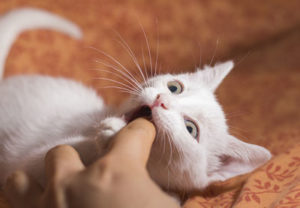
©josemanuel246/Adobe Stock
After working with many different personalities in cats, I’ve come to discover there are a few games that—while extremely popular—are also games you’ll regret in the end. Now you can benefit from my experience: Here are some games your cat will adore, but you will come to regret.
Bed Mouse: This is just about any cat’s most favorite game: a person places their hand under the bed covers and moves it a bit. Your cat will be hypnotized and eventually pounce. It’s fun at first, but you’ll soon discover that your cat is crepuscular, which means he is most active at dusk and dawn. That means you had better plan on getting up at dusk and dawn because any body part that moves under covers is now fair game. This makes for a late night problem when your feet become the “mice.”
Hands and Feet: There aren’t too many games I don’t recommend, but a good general guideline is to never use your hand or foot as “prey.” It’s a bad habit to get into and you leave yourself open for attack whenever your cat feels like playing.





